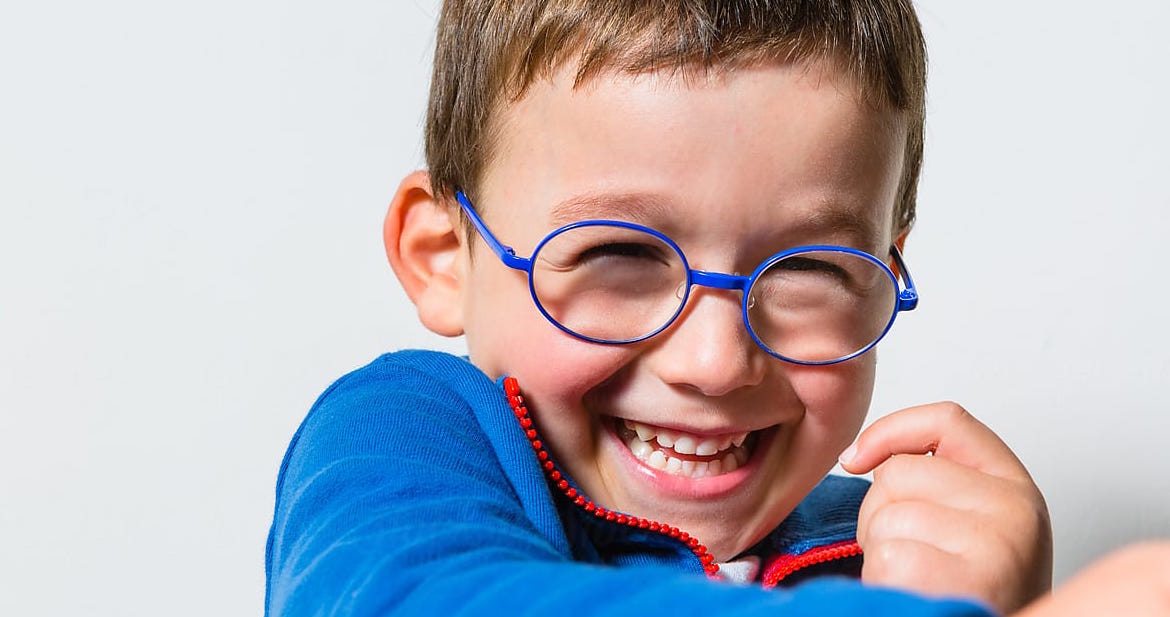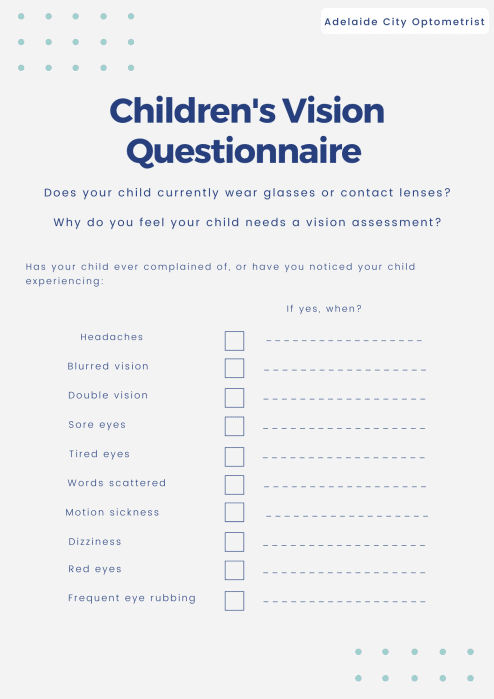
If you’re busy checking off your back to school list, don’t forget to add an eye test for your kids! Clear vision is essential in your child’s success and learning in school.
Children should have their eyes tested biennially (every 2 years) and especially just before they start school at the age of 5 or 6. Kid’s vision may change frequently during the school years as they grow, so it is important to keep an eye on their vision and notice if anything changes that could keep them from excelling in their studies.
This year, 1 in 5 children will head back to school with an undetected vision problem. According to The 2020 Vision Index, commissioned by Optometry Australia, 29% of Australian parents do not believe they need to take their children to the optometrist until they are older.
If there are any genetic eye issues in your family, then it is recommended to take your child to an optometrist as these issues are more likely to surface and can be monitored at an earlier stage.
The most common eye problems amongst children are refractive errors. These are:
- Hyperopia, or farsightedness. Children with hyperopia can see distance objects well, yet have difficulty focusing on objects that are close.
- Myopia, or nearsightedness. This is the most common cause of impaired vision in children, which causes objects in the distance to be blurry.
- Astigmatism, which causes blurry or distorted vision, no matter the distance.
Below, we guide you through the top nine signs to look out for, which suggest your child may have an undetected vision problem, and it’s time for a children’s eye test.
WHAT ARE SOME SIGNS THAT MY CHILD NEED’S AN EYE TEST?
1. Squinting, Or Difficulty Recognising People In The Distance
If your child is sitting too close to the TV or computer, asking to sit up the front in class to see the board, or doesn’t recognise grandpa from across the room, it is likely a sign that they are suffering from one of the fastest growing health epidemics in the world – myopia.
2. Frequent Eye Rubbing
While we all find ourselves rubbing our eyes occasionally, doing so constantly may be a sign of an eye problem – especially if you notice that your child is doing it while they are trying to concentrate on something, such as reading a book.
3. Using A Finger To Guide The Eye While Reading
Children often use their finger to guide when they learn to read. However, as their reading skills develop, they should be able to focus and not lose their place.
4. Falling Grades
As we mentioned earlier, 80 percent of learning is visual, meaning that vision is a crucial factor that influences learning ability. Falling grades at school could be a sign of a vision problem, whereby your child has trouble seeing the board or screens.
5. Head Tilting
Head tilting is a physical symptom often related to an eye issue. It is often a sign that your child requires an eye check.
6. Complaints Of Headaches
Eye muscles can work harder to put images or words into focus. Consequently, this can cause eye fatigue or eye strain, which results in headaches.
7. Sensitivity To Light
Severe sensitivity to indoor light, sunlight or camera flashes is often a sign of an eye or vision problem.
8. Closing One Eye When Reading Or Watching TV
Have you noticed your child frequently reading or watching a screen with one eye closed? This could indicate a refractive or binocular vision problem that is influencing the ability of the two eyes to work together.
9. Avoiding Using A Screen Because Their Eyes Hurt
Digital eye strain is common amongst kids, teens and young adults. It often results in sore eyes, meaning your child may have difficulty using, or not want to use, electronic screens.
When you arrive at the appointment, you will be asked to fill out a Children’s Vision Questionnaire. This will provide us with a thorough understanding of your child’s habits, vision as well as hobbies etc, to get an overview of what vision care your child will require. (Below is an example of 1 of the pages for the questionnaire)
WHAT CAN I EXPECT AT MY CHILD’S EYE TEST?
The eye test will be slightly different depending on the age of your child, e.g. if your child is not of talking age yet, the optometrist won’t be asking the child questions but rather speaking to the parents more.
The optometrist will do a physical exam of your child’s eyes and also do vision screenings using eye chart tests, pictures or letters, and a form of visual acuity (measuring how well the eyes can distinguish shapes and the detail of objects at a given distance)
The eye doctor will also dilate your child’s eyes, as it purposefully increases the size of the pupil during an eye exam. Then will fully examine the health of the optic nerve and retina. This exam is critical to preventing and treating eye conditions that could lead to vision loss, but also is a useful way to check a child’s eyes without having to ask too many questions.
To monitor your child’s eye health, booking an eye exam every 2 years unless otherwise advised, is vital to ensure the vision doesn’t worsen or unexpectedly or there aren’t any other underlying conditions present.
WILL AN EYE TEST DETERMINE EARLY SIGNS OF SHORT-SIGHTEDNESS?
An eye exam can determine whether your child has early signs of short-sightedness and generally can be managed at the early stage with contact lenses or can be assisted with glasses.
Orthokeratology, or Ortho-K, is the process of fitting special contact lenses to reshape the cornea. Ortho-K uses gas permeable contact lenses designed to be worn overnight rather than during the day. While the patient sleeps, the lenses gently and gradually reshape the surface of the eye. This is a great option to correct refractive errors for kids and can prevent glasses in the long run (at least for while they are growing) if started early enough.
The other option which assists with the eye sight issue is the use of eyeglasses. However, glasses only assist and give your child the vision they need but it will not correct their vision like Ortho-K does.
The Myopia Epidemic
In addition to general eye problems, you may have recently heard about the worldwide epidemic of myopia in children. The prevalence of myopia is increasing at an alarming rate globally. Consequently, this comes with a host of health risks. People with myopia have increased lifetime risk of glaucoma, posterior sub capsular cataracts, retinal detachment, and macular degeneration.
The first step in myopia control and management is a children’s eye test, to determine whether or not your child suffers from the condition. Our optometrist, Paul Fotkou, is then able to help you and your child with management. This includes the option of glasses or contact lenses, which can reduce the progression of myopia. Recently, contact lenses designed solely for children with myopia have been released. These soft contact lenses have been found to significantly slow the progression of myopia; in some cases, this can be by up to 50 percent, compared with no management plan.
Greater outdoor play has also been found to reduce the severity of myopia in children. Additionally, part of the myopia management plan is personalised vision training. Paul Fotkou uses technology to precisely measure and record eye movement, delivering objective, graphical results in the form of a detailed report. This makes it easy for us, you, your children and teachers to understand how the eyes are actually working, and helps us manage the next steps in assisting your children. The result? Improved, more effective vision care.


